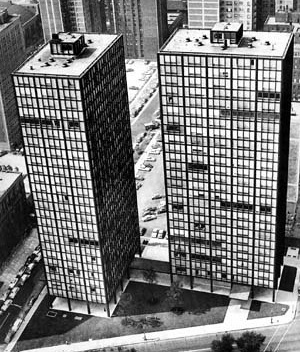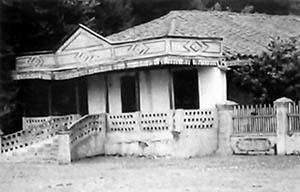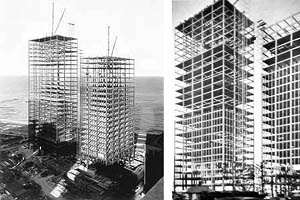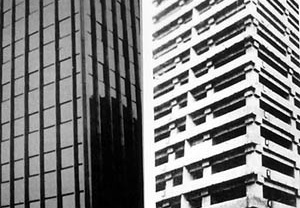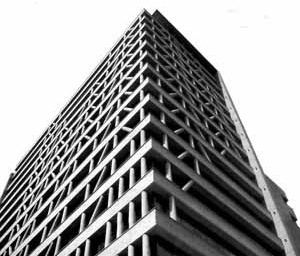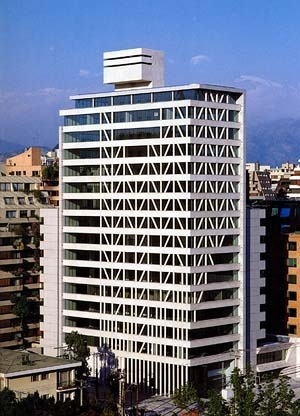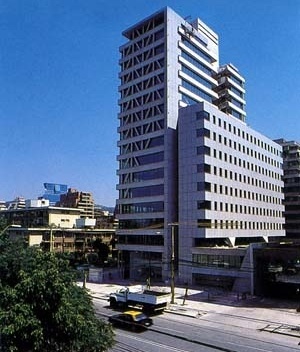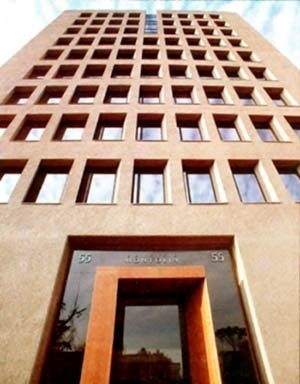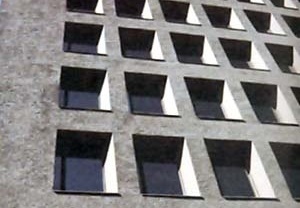In order to get a more rewarding attitude regarding architecture and its identity I believe it is convenient to begin with some basic remarks:
1
The first of them is to acknowledge that we, designer architects, shall deal with this subject differently from the way a historian or sociologist would. The historians focus on data already happened, already arranged and closed; besides, they master the standpoint of the whole and the understanding of the facts allowed only by the distance in time. Thus, they are able to organize conceptually the most important issue and to characterize the essence of the episode.
Historians’ and sociologists’ contributions are indispensable to us, designer architects, so as to understand the internal logic of the identity phenomena in architecture (and the phenomena of architecture in general). Since it is not a mere mechanical sequence of influences on the architectural shapes of the past upon the present time ones, as one can infer from the "autonomous architecture" fallacies, but it is all about cultural phenomena rooted in the human beings own nature: the architects who have designed the buildings, the users and the developers and builders – buildings do not put up themselves alone.
More than once, I have heard the "autonomist" fallacy assuming that the contemporary Mexican architecture, for example, is basically a sequential continuation of the magnificent pre-Columbian architecture. However, these explanations, that sound so logical and with some very good examples, – as the nice Museo Rufino Tamayo – are not enough, since the pre-Columbian architecture does not explain Barragan’s or Legorreta’s architecture. Neither does it explain the fantastic modern architecture of a country like Brazil…, which never had a pre-Columbian architecture. And if we focus on the other high quality pre-Columbian architecture, the Peruvian one… we find out that Peru contemporary architecture has not been as potent in terms of identity as the Mexican architecture. The explanation of the form, just starting from itself, does not suffice at all. Architecture is not autonomous.
This explanation done, we can go back to our initial remark: the method of approaching the issue of identity in architecture is quite different depending on the professional who carries it out – be it a historian of architecture, a historian, a sociologist or a designer-architect. The former ones focus on facts already happened, arranged, closed and far away in time. On the contrary, the designer-architects try to create proposals to be carried out presently: "here and now", each day in our drawing tables.
What shall we do?
Shall we rapidly take some “characteristics of the X identity of our countries" as defined by some kind of expert and apply them to our designs? Quite obviously this is not a convincing answer.
It is not legitimate to seize literal characteristics from architectural identity of the past – for example, in Chile, the gorgeous colonial roofs of clay tiles – for the current technical conditions are, by and large, completely different from those when such roofs had been erected. That is why the mere action of repeating them mechanically and in an unnatural way, would totally contradict the real meaning and the logic that such cultural events have had in their time.
Neither it is valid to take characteristics from what we can call the ‘collective being’ of a nation’s identity. However it is not because such identity does not exist, but because when you talk about accomplishments, every cultural basis is so complete, rich and subtle that any attempt of verbalized definition can cast a shadow more then lighten up its reality. For example, even if it is quite correct to situate Chilean identity, as a direct descendent of the South American catholic baroque, and it can be more colorful than a Nordic Finish identity… this "colorfulness" may seem really tricky to anybody whom, from another point of view, would compare the "Chilean gray personality" with the “Brazilian colorful personality"… Or even inside Brazil itself if we are to compare the "Paulista economical personality" with "the Carioca exciting personality", etc. Thus, we can conclude that such "pre-defined characteristics" are of very little use to the effective actions of doing architecture.
Therefore when we architects see the issue of identity as the need to seek for a kind of "pre-defined list of the X identity characteristics" and before long, find and recover them, we face an impossible mission: this ‘recuperation’ is not inherently feasible.
2
It is not feasible because even though the idiosyncratic cultural bases seem to be quite stables, – the differences between Germans and Italians have been and are going to be recognizable for centuries – the concrete manifestations where these idiosyncrasies remain are pretty dynamic. For instance, albeit the bossa nova rhythm keeps on being a form of samba, the jazz influence – with which it had combined – turned it into a very different music. In this sense, "cultural identity" is quite apart from being a metaphysically invariant unreality: "identity is not essence, but history"… has said Octavio Paz.
Actually, the creativity of the cultural manifestations is always changeable: with some great moments that will soon be down… to come back later. I remember, when I first came to Brazil, I fell deeply in love with bossa nova. In the evenings we used to listen to young singers such as Nara Leão and Edu Lobo, Jorge Ben’s songs, and also Jobim’s, João and Astrud Gilberto’s, and the musical wonders of Baden Powell and his guitar, a match box near the microphone and a metronome. And in the following morning, on the beaches of Arpoardor, we would repeat the same songs to the tall and slender Girls from Ipanema, to the waiters and waitresses of a bar named Castelinho, and to the nannies that went along gracefully with their children in their baby carriages. This kind of samba, with some jazz influence, which used to hit every age and social group in Rio de Janeiro, this kind of "national identity" of the Brazilian popular music, at that time prosperous in Rio (to my tourist’s eyes) was something magic and unexplainable that has gotten me deeply and permanently.
Fifteen or twenty years later, returning to Brazil, this wonder had quite almost vanished. It seemed to have fulfilled the sad prophecy of that song – “My poor samba, it went on mixing, modernizing itself and got lost” (“pobre samba meu, foise mixturando se modernizando e se perdeu”). But this had happened in an unexpected sense: here it was nothing about the jazz influence over samba, but the simple domination of the Brazilian music by the North American style.
What happened? In a period of 15 or 20 years had Brazilians lost their cultural identity? A more likely explanation is that the numerous circumstances of creative soul are recurring: they come; they go, and come back, etc…
My foreign eyes seemed to be watching something similar when I looked at Brazilian modern architecture. In different phases along the years 1930-60 such architecture has seen and lived brilliant moments, whose magnificent works keep on marveling us to the present time. Nonetheless, these moments seem to be currently in recess. I do not mean that architectural quality has disappeared: the remodelation of Pinacoteca de São Paulo, carried out by the Brazilian architect Paulo Mendes da Rocha, winner of the Mies Award in 2002, seems to be a masterpiece (2). It is not the same though: in this work we cannot notice the shine of that architectural modernity, in such an assertive and insolently Brazilian way, which used to detach itself in front of our eyes in its brilliant moments.
We shall stop here for the moment, remarking that cultural identity manifestations correspond to frame of mind, or attitudes, which by being historical are intrinsically floating.
3
Shifting the approach to our subject, it is interesting to remark that for us, Iberian-Americans, the identity issues are inseparably connected to the modernity issues.
Given that our modernity has not been formed from endogenous processes – and perhaps spontaneous ones –, as it has occurred in the nations with a prior modernizing process (those which went on inventing their modern manifestations "on the route"), but it has been formed by the healthy "manifestation effect" of the already modern countries, each time we adopt a modern way we are not quite sure if it is an authentic expression of ours or if we are just doing a kind of symbolic imitation of a modernity fetish, which arises our most unsuspecting non-critical admiration. For centuries, Chilean elites had confounded "being modern" with "being just like the French" and, even later with "being just like the North-Americans". I do not mean not to enjoy the significant lessons we can learn from more and earlier developed countries: on the contrary, this is a very valuable asset when talking about civilization (3), but which operates in a very distinct way in the cultural sector, where identity real sense lies.
Is it "modern" to build in Santiago those curtain-wall buildings, without any kind of sun protection? And in an area whose radiation is equivalent to that in Marrakech, in North Africa (33 degrees in latitude)? For many of us, this kind of absurd is a symbol of modernity to proudly show-off. The negative effects provoked by such real "heat accumulators" – the curtain-walls – are used to being badly compensated by the expensive and wasting-energy air-conditioning equipment in all those called "intelligent buildings", just because this kind of waste is computer-handled. Therefore this ridicule method of misunderstanding modernity leads us to the ironic fact that – the more stupid the architects seem to be (4), the more intelligent the buildings have to be.
Well, this consideration about our cultural identity leads us sooner than later to a careful thought about modernity. When this happened to me, decades ago, I prompted myself to face a revision of this matter, doing what would be called today a "reengineering" of the modernity concepts.
What is "modernity" in architecture? How can we describe modernity in itself, in a conception valid in every field, in a way modernity itself requires?
In previous essays we have seen that among the efforts of answering this crucial question, the more synthetic and understanding one I have found is the attempt which, even referring to the religious anthropology, can be extrapolated to the concept of modernity in general: modernity characterized as the historical challenge of moving from a "received order" to a "produced one" (5). For example:
- In political aspect, to shift from a divine right of the sovereigns (received order) to the people’s sovereignty (produced order);
- In the philosophical side, to shift from a Theo-centric cosmo-vision (received order) to an anthropocentric cosmo-vision (produced order);
- In the ‘should be’ aspect, to shift from a religiously founded moral (received order) to an ethics supported within the social conviviality: v. gr. the Kantian categorical imperative (produced order).
- In the architectural aspect, to shift from seeing it like the academy-imposed handbook canons used to (received order) to seeing it as the search for living forms more suitable to the potentialities, the desires and the sensibilities of a particular society (produced order).
This characterization expresses the core itself of the modern attitude: the aspiration to a wider level of critical questioning and freedom and the consequent longing to a more effective and active participation in the improvement and development of the world… to move from a received order cosmo-vision to a to-be-produced order.
And then, this simple and powerful characterization organizes the preliminary things; since before it, it is quite evident for example that to non-critically reproduce the American curtain-wall – without its previous "appropriation" to our reality – is, as a matter of fact, to submit ourselves to a received order: an anti-modern attitude.
With this kind of "reengineering" of the concept of modernity, we realize it basically consists of an attitude before reality itself: to be authentically modern involves the attitude of thinking and acting in an appropriate form from and to the reality itself.
This is what we call "cultural assertiveness attitude", which always ends up in an appropriate modernity.
4
How to encourage the coming out of this "cultural assertiveness attitude"?
The cultural assertiveness is a sane attitude… so, its contrary – the cultural alienation – can be seen as an ailing attitude. And according to what I haven already seen and lived, a good way to arise the sane attitude of cultural assertiveness is to attack and highlight the ill attitude of alienation: to be aware of the pathetic vanity of our ridicule alienations.
In adopting this approach I have noticed that our architectural alienations seem to be attached to our desire of being modern; but a misunderstood one among the architects such as the yearning to be inside the modernity manifestations of other more advanced societies: other societies, other stories, other realities. Say, a sham longing for "pseudo-modernity", which is the origin of our architectural alienations. That is why I have focused on a more tangible subject – to find concrete manifestations of our cultural alienations to highlight them: in other words, to underline the ailment so that sanity can be underscored, by contrast.
A good example of this can be noticed in the photograph (1) of a country colonial house in Lo Orrego Arriba, in the Chilean Central Valley. When it was constructed it was made of honest adobe walls and covered with clay tiles, in a kind of architecture quite suitable to the weather, background, traditions and available technologies in Chile, at the time. In this sense, this architecture was indisputably appropriated… from and to its reality.
This authenticity was ridiculously tailored in the early 19 century when the house was "pseudo modernized" with the superimposition of a pediment of painted timbers just like "French" neoclassic stucco. This pseudo-"French style"-modernization is as pathetic as those later copies of the concrete fetish seen “a la Corbusier” (another way of "French style") in the Chilean proto-modernity – when still a pre-industrial society, we have used the technology of the exposed concrete to apply the modern desire of coherence between aesthetics and technology… with a non-existing technology among us.
Differently from what happened for instance in Colombia, when a disciple of Le Corbusier, Rogélio Salmona, rather than literally copy the concrete fetish, responded to the modern yearning of coherently combining technology and aesthetics with a Colombian genuine and tangible technology: the excellence of Bogotá brickwork technology. In so doing, he has generated the remarkable brick Bogotan architecture, which has become a paradigm: not an alien received order, but a produced order from and to its own reality: a truly modern architecture.
With this "re-engineering" of the concept of modernity, it is quite clear that that alien pseudo-modernization in "French style" – which was done to the houses in Orrego Arriba – is the servile adoption of a received order; similarly as we can notice in the Corbusian exposed concrete copy in pre-industrial Chile, in the early 20th century. And similarly to our current contemporary curtain-walls, they are pseudo-modernity examples, in fact, anti-modern ones. It becomes quite clear, then, that Rogelio Salmona’s – and other Colombian architects’ – sane attitude was the real and authentically modern approach.
Due to this consciousness, in 1986, during the SAL (6) in Manizales, Colombia, I developed the concept of appropriate modernity, suitable to each own reality… from and to this reality. Since then, this concept has been widely accepted in Latin America.
In current Chile this consciousness, combined with other circumstances that increased our confidence in ourselves and in our future, balanced with a good dose of humility (realism) one arrives at a sane and powerful reaction against the cultural alienation – which is a problem originated in and by ourselves (7) – and thus we have critically matured… so that attitudes of cultural assertiveness may arise in ourselves.
5. Alienation and appropriation: some Chilean examples
As it is well known the widespread curtain walls were designed for the first time by Mies van der Rohe in the buildings on Lake Shore Drive, Chicago, in the early 1950s. They embody a masterpiece of the modern yearning of coherence between aesthetics and technology, as we can clearly see in photos 2 (building phase) and 3 (finished façade): the structure of the buildings during construction and the aesthetic appearance of its façades, just after completion, highlighting the quite evident coherence between technology and aesthetics.
Just the opposite can be noticed in the façade of a building in Santiago de Chile (photo 4), whose curtain wall façade is quite similar to those in Mies buildings. In the following image one (photo 5) can see its structure while in construction and the complete incoherence between the heavy concrete technology – used to face the Chilean earthquakes –, and the aesthetic appearance of a "light steel and glass" curtain wall, completely distant from our reality. Rather than reaching the cultural assertiveness of an aesthetic approach from the structural technological features required by our seismic reality, the architect disguises the building in "a modern way", shamefully denying its own reality… just like a monkey dressed in silk. That is what we call a cultural alienation attitude.
But, also in Chile we have a fantastic example of coherence between the structural technology – required to absorb the horizontal efforts and the provoked torsions of our earthquakes – and the aesthetic expression of the buildings façades. That is the case of the Manatiales Building, designed by the architects Izquierdo, Lehmann, Lira and Peñafiel. Its coherence between technology and aesthetics is so notable (photos 6, 7 and 8). This building, which was a finalist in the Mies van der Rohe Award in 2002, is a very successful case of what we call cultural assertiveness attitude.
Another example is the Building Montolin, designed in 1980s in my studio. Responding to the prevalent realities in Santiago, with its high solar radiation (33º South Latitude), this building shows its different façades according to the solar protection required by each orientation. We can see three of its four façades. The North façade, the sunniest one in the South hemisphere; the west façade which faces the street (photo 9) and the south façade, which gets almost no solar radiation and shows its curtain wall without any protection.
The north façade is protected by a transparent lattice net, which once the building is completed, will be covered with deciduous ivy plants, which work according to the season of the year: they are evergreen in summer, when a good shade is needed, and they almost disappear in winter when solar heat is welcomed. In the photo 10, we can see this vegetal curtain wall growing. And the west façade (photo 11) is protected by the powerful structural wall diagonally perforated by windows, protected by the shade provided by the structure itself.
6. In brief
Being architecture a manifestation from and to the human nature, the contributions from Sociology, Architectural Historiography, and History are indispensable to understand its phenomena. Despite all that, the designer-architects’ task, as far as identity is concerned – to create an appropriated architecture from and to each reality – requires different approaches from those provided by sociologists or historians. The crux of the matter is an attitude of cultural assertiveness, understood as the creative acceptance of the advantages and requirements of each society, in accordance with its values and peculiarities. An attitude of appropriate contemporaneousness which in some societies come up "spontaneously", and in those ones where this does not happen, it can be aroused by highlighting the negativities of the opposite attitude: the alienation of those who want to look like what they are not.
Architects should keep in mind that cultural identity is no rational essence “to seek and find” , but a experiencing phenomenon, which is being created in the social development; and when the cultural assertiveness attitude flourishes in a certain society, it is possible for each architect, having faced his own task case by case, to entirely work out his architectural problem.
Commenting the Gospel wisdom:
… Search with humility (realism) and creative imagination the appropriation and the beauty from and to your reality… and modernity and identity... shall be added to you...
notes
1
This text was written as a contribution to the research project “Architecture & Identity”, coordinated by Prof,Dr.Peter Heerle, Habitat Unit, TU Berlin, on demand of architect Ruth Verde Zein, local partner (Brazil/Latin America). http://www.architecture-identity.de/research_home.htm.
2
My opinion was formed over other people’s comments and examination of blueprints. Since I have not been there, I cannot be quite sure of it.
3
Here I make use of Alfred Weber’s categories of the terms civilization and culture.
4
Stupid: in cyber slang, the being that does not change its behavior before the variations of its reality.
5
This is a definition of Marcel Gauchet, quoted in LECHNER, Norbert.Subjectividad y Politica. Fondo de Cultura Econômica, 1990. Chile.
6
SAL. Latin American Architecture Seminars.
7
And not originated from evil foreign potencies as sometimes is claimed by our plaintive Latin-American self-pity.
about the author
Fernández Cristián Cox, Chilean architect and critic, author of "America Latina New Architecture" (Gustavo Gili, 1998) was winner of the National Architecture Award 1997 from the College of Architects of Chile



